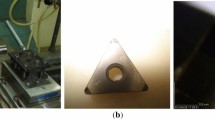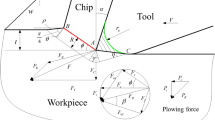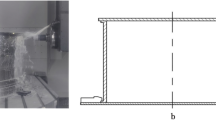Abstract
Weak rigid parts are widely used in aerospace industry. These parts are characterized by thin walls. Most of these parts have the meter-level size and mesh surface, thus have a requirement for tool accessibility. Therefore, the end milling is an applicable process to reduce the thickness of these parts. Due to the weak rigidity of these parts in the normal direction, severe chatter will occur in the machining process, which will reduce the machining efficiency and spoil the machining surface, so the processing stability of the thin-walled part needs to be studied. In this paper, the dynamic model for end milling of thin-walled parts is presented. The regeneration effect in the surface normal direction is proposed, and the dynamic equation is constructed considering the vibration of the workpiece in the cutting tool axial direction. The stability lobe diagram is obtained by numerical method. It is found that the stability of weak rigid parts end milling is related to the cutting speed, the feed rate, and the width of cut, but not to the cutting axial depth. Finally, cutting experiments are conducted. The experimental result is coincident well with the prediction, thus verifying the proposed dynamic model and the stability analysis method.








Similar content being viewed by others
References
Burtscher J, Fleischer J (2017) Adaptive tuned mass damper with variable mass for chatter avoidance. CIRP Ann 66(1):397– 400
Kolluru K, Axinte D, Becker A (2013) A solution for minimising vibrations in milling of thin walled casings by applying dampers to workpiece surface. CIRP Ann 62(1):415–418
Bolsunovsky S, Vermel V, Gubanov G, Leontiev A (2013) Reduction of flexible workpiece vibrations with dynamic support realized as tuned mass damper. Procedia CIRP 8:230–234
Zhang X, Wang C, Liu J, Yan R, Cao H, Chen X (2019) Robust active control based milling chatter suppression with perturbation model via piezoelectric stack actuators. Mech Syst Signal Process 120:808–835
Chen F, Hanifzadegan M, Altintas Y, Lu X (2015) Active damping of boring bar vibration with a magnetic actuator. IEEE/ASME Trans Mechatron 20(6):2783–2794
Chen F, Lu X, Altintas Y (2014) A novel magnetic actuator design for active damping of machining tools. Int J Mach Tools Manuf 85:58–69
Altintas Y, Budak E (1995) Analytical prediction of stability lobes in milling. CIRP Ann 44 (1):357–362
Montgomery D, Altintas Y (1991) Mechanism of cutting force and surface generation in dynamic milling. J Eng Ind 113(2):160– 168
Altintas Y, Montgomery D, Budak E (1992) Dynamic peripheral milling of flexible structures. J Eng Ind 114(2):137–145
Budak E, Altintas Y (1998) Analytical prediction of chatter stability in milling—part ii: application of the general formulation to common milling systems. J Dyn Syst Meas Control 120(1):31–36
Budak E, Altintas Y (1995) Modeling and avoidance of static form errors in peripheral milling of plates. Int J Mach Tools Manuf 35(3):459–476
Mann B P, Young K A, Schmitz T L, Dilley D N (2005) Simultaneous stability and surface location error predictions in milling. J Manuf Sci Eng 127(3):446–453
Eksioglu C, Kilic Z, Altintas Y (2012) Discrete-time prediction of chatter stability, cutting forces, and surface location errors in flexible milling systems. J Manuf Sci Eng 134(6):061006
Rubeo M A, Schmitz T L (2016) Global stability predictions for flexible workpiece milling using time domain simulation. J Manuf Syst 40:8–14
Lee A C, Liu C S, Chiang S T (1991) Analysis of chatter vibration in a cutter-workpiece system. Int J Mach Tools Manuf 31(2):221–234
Schmitz T L, Honeycutt A (2017) Analytical solutions for fixed-free beam dynamics in thin rib machining. J Manuf Process 30:41–50
Fei J, Lin B, Xiao J, Ding M, Yan S, Zhang X, Zhang J (2018) Investigation of moving fixture on deformation suppression during milling process of thin-walled structures. J Manuf Process 32:403–411
Liu Y, Wu B, Luo M, Zhang D (2015) Modeling and cutting path optimization of shallow shell considering its varying dynamics during machining. Procedia CIRP 31:521–526
Davies M, Balachandran B (2000) Impact dynamics in milling of thin-walled structures. Nonlinear Dyn 22(4):375–392
Meshreki M, Attia H, Kövecses J (2011) Development of a new model for the varying dynamics of flexible pocket-structures during machining. J Manuf Sci Eng 133(4):041002
Sun Y, Jiang S (2018) Predictive modeling of chatter stability considering force-induced deformation effect in milling thin-walled parts. Int J Mach Tools Manuf 135:38–52
Shi J, Song Q, Liu Z, Ai X (2017) A novel stability prediction approach for thin-walled component milling considering material removing process. Chin J Aeronaut 30(5):1789–1798
Song Q, Shi J, Liu Z, Wan Y (2017) A time-space discretization method in milling stability prediction of thin-walled component. Int J Adv Manuf Technol 89(9-12):2675–2689
Quintana G, Ciurana J (2011) Chatter in machining processes: a review. Int J Mach Tools Manuf 51(5):363–376
Budak E, Altintas Y (1998) Analytical prediction of chatter stability in milling—part i: general formulation. J Dyn Syst Meas Control 120(1):22–30
Merdol S, Altintas Y (2004) Multi frequency solution of chatter stability for low immersion milling. J Manuf Sci Eng 126(3):459–466
Ding Y, Zhu L, Zhang X, Ding H (2011) Numerical integration method for prediction of milling stability. J Manuf Sci Eng 133(3):031005
Thevenot V, Arnaud L, Dessein G, Cazenave-Larroche G (2006) Integration of dynamic behaviour variations in the stability lobes method: 3d lobes construction and application to thin-walled structure milling. Int J Adv Manuf Technol 27(7-8):638–644
Özgüven HN (1990) Structural modifications using frequency response functions. Mech Syst Signal Process 4(1):53–63
Alan S, Budak E, Özgüven H N (2010) Analytical prediction of part dynamics for machining stability analysis. Int J Autom Technol 4(3):259–267
Yang Y, Zhang W, Ma Y, Wan M (2016) Chatter prediction for the peripheral milling of thin-walled workpieces with curved surfaces. Int J Mach Tools Manuf 109:36–48
Tuysuz O, Altintas Y (2017) Frequency domain updating of thin-walled workpiece dynamics using reduced order substructuring method in machining. J Manuf Sci Eng 139(7):071013
Tuysuz O, Altintas Y (2018) Time-domain modeling of varying dynamic characteristics in thin-wall machining using perturbation and reduced-order substructuring methods. J Manuf Sci Eng 140(1):011015
Song Q, Liu Z, Wan Y, Ju G, Shi J (2015) Application of sherman–morrison–woodbury formulas in instantaneous dynamic of peripheral milling for thin-walled component. Int J Mech Sci 96:79–90
Wan M, Lu M, Zhang W, Yang Y (2012) A new ternary-mechanism model for the prediction of cutting forces in flat end milling. Int J Mach Tools Manuf 57:34–45
Altintas Y (2000) Manufacturing automation. Cambridge University Press, Cambridge
Yang Y, Zhang W, Ma Y, Wan M, Dang X (2019) An efficient decomposition-condensation method for chatter prediction in milling large-scale thin-walled structures. Mech Syst Signal Process 121(APR.15):58–76
Funding
This study was supported by the Joint Innovation Found of China Academy of Launch Vehicle Technology(CALT201809), the National Natural Science Foundation of China (Grant No. 51875357), and the Joint Research Fund of Shanghai Aerospace Advanced Technology (USCAST2019-16).
Author information
Authors and Affiliations
Corresponding author
Ethics declarations
Conflict of interest
The authors declare that they have no conflict of interest.
Additional information
Author contributions
Haoqi Dong wrote this article, processed the experimental data, and analyzed the results. Yulei Ji put forward the experimental scheme and demonstrated the feasibility of the study. Xinzhi Wang did the experiment. Qingzhen Bi was responsible for guiding the work and revising the article.
Data availability
The authors declare that the data and the materials of this study are available within the article. The raw data are also available from the authors upon a reasonable request.
Publisher’s note
Springer Nature remains neutral with regard to jurisdictional claims in published maps and institutional affiliations.
Rights and permissions
About this article
Cite this article
Dong, H., Ji, Y., Wang, X. et al. Stability analysis of thin-walled parts end milling considering cutting depth regeneration effect. Int J Adv Manuf Technol 113, 3319–3328 (2021). https://doi.org/10.1007/s00170-021-06610-9
Received:
Accepted:
Published:
Issue Date:
DOI: https://doi.org/10.1007/s00170-021-06610-9




